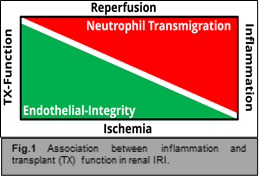Given the clinical impact of DGF, new strategies are urgently needed to ameliorate the unavoidable IRI in kidney transplantation, with Bryostatin-1 (a protein kinase C delta blocker PKCδ)) being a most promising candidate. Bryostatin-1 has been initially described as an anti-cancer drug and since then its safety, efficiency and therapeutic potential have been repeatedly proven in a variety experimental studies as well as clinical Phase I and Phase II trials. Recently, our collaborators described an additional mechanism of action for Bryostatin-1, which is a near complete blockade of in vitro neutrophil TEM through activation of the EC second messenger PKCδ.
For this novel ‘partners-across-campus` project, we and our international collaborators are transferring the newly obtained results of Bryostatin-1 as a potent inhibitor of neutrophil TEM for the field of transplant medicine, using both relevant in vitro as well as translational in vivo models. This project will validate protective effects of Bryostatin-1 in the continuum of renal IRI in a preclinical model of kidney autotransplantation.




